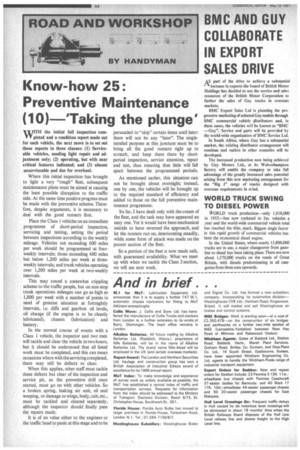Know-how 25 Preventive Maintenance (10) 'Taking the plunge
Page 46

If you've noticed an error in this article please click here to report it so we can fix it.
WH the initial full inspection cornpTeted and a condition report made out for each vehicle, the next move is to set out these reports in three classes: (1) Serviceable vehicles, needing light repair and adjustment only (2) operating, but with near critical features indicated; and (3) almost unserviceable and due for overhaul.
Where this initial inspection has brought to light a very "rough" fleet, subsequent maintenance plans must be aimed at causing the least possible disruption to the traffic side. At the same time positive progress must be made with the preventive scheme. Therefore, despite arguments, it is necessary to deal with the good runners first.
Place the Class 1 vehicles on an immediate programme of short-period inspection, servicing and testing, setting the period between inspections according to the weekly mileage. Vehicles not exceeding 600 miles per week should be programmed at fourweekly intervals; those exceeding 600 miles but below 1,200 miles per week at threeweekly intervals; and trunk vehicles operating over 1,200 miles per week at two-weekly intervals.
This may sound a ,somewhat crippling scheme to the traffic people, but on non-stop trunk operations mileages can go as high as 1,800 per week with a number of points in need of genuine attention at fortnightly intervals, i.e. diffs and gearbox oil levels, oil change (if the engine is to be cleanly lubricated), chassis (lubrication) and battery.
In the normal course of events with a Class 1 vehicle, the inspector and two men will tackle and clear the vehicle in two hours, but it should be understood that all listed work must be completed, and this can mean occasions where with the servicing completed, there may still be defects to clear.
When this applies, other staff must tackle these defects but clear of the inspection and service pit, as the preventive drill once started, must go on with other vehicles. So a broken spring, leaking air unit, oil seal weeping, or damage to wings, body, cab, etc., must be tackled and cleared separately, although the inspector should finally pass the repairs made.
It is of no value either to the engineer or the traffic head to panic at this stage and to be persuaded to "skip" certain items until later: there will not be any "later". The singleminded purpose at this juncture must be to bring all the good runners right up to scratch, and keep them there by shortperiod inspection, service attention, repair and test, thus ensuring that little will fall apart between the programmed periods.
As mentioned earlier, this situation can not be brought about overnight; instead, one by one, the vehicles will be brought up to the required standard of efficiency and added to those on the full preventive maintenance programme.
So far, I have dealt only with the cream of the fleet, and the task may .have appeared an easy one. Yet it would have been mechanical suicide to have reversed the approach, and let the runners run on, deteriorating steadily, while some form of attack was made on the poorer section of the fleet.
So a portion of the fleet is now made safe, with guaranteed availability. What we meet up with when we tackle the Class 2 section, we will see next week.




















































































































